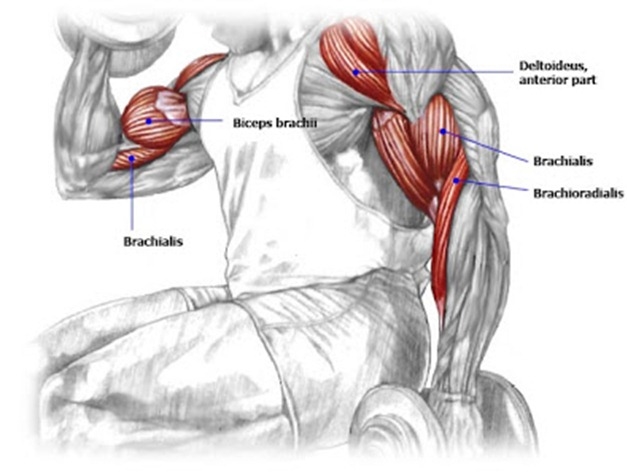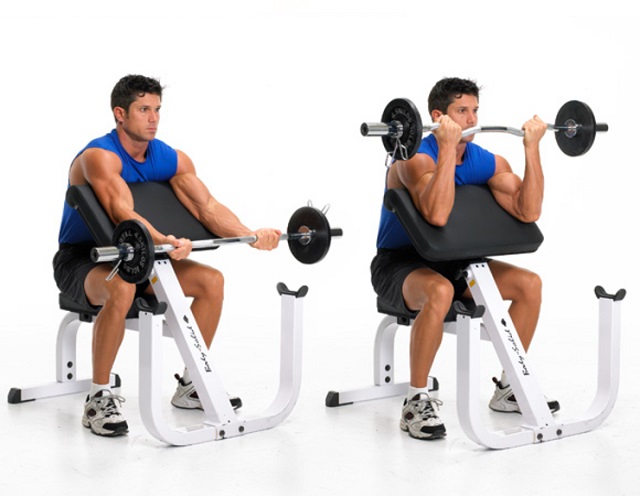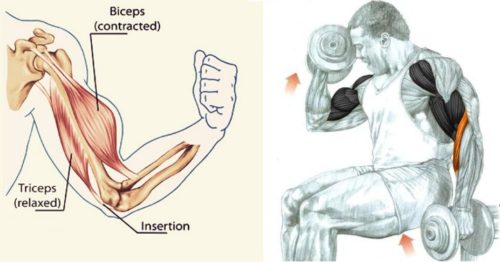Train the brachialis, this elbow flexor is often overlooked in arm training workouts. Without training the brachialis regularly and with the appropriate amount of stress, you can’t maximise your biceps peak. This is due to its position under the biceps, the brachialis has the ability to push the bicep up as it gains size. This doesn’t mean that you shouldn’t train your biceps directly, make sure that each one of thes arm muscles get the required amount of work in order to grow.

What Is The Brachialis?
The biceps brachii has two separate heads, the long head and the short head. The long head attaches just above the shoulder and forearm, the short head attaches onto the shoulder and the inside of the forearm. Both heads combine to form a common tendon at the elbow but form two different tendon attachments at the shoulder. Each head is responsible for a few same but also for many different movement patterns.
The long head is known as the outer bicep and the short head is known as the inner bicep. With the right exercises, it’s possible to focus on one head or the other during curls. The narrow grip on barbell curls can help you emphasise the work of the long head. The wide grip curls will target the short head more. Since the long head of the biceps crosses the shoulder joint, train it as thoroughly as possible, pre stretch the long head in order to force it to work harder.
Bring your elbows forward a little as you approach the top position of the movements, this causes your long head to contract harder and achieve a fuller contraction at the top.You don’t have to use a variety of hand positions and angles to achieve optimal stimulation of the brachialis. However, that doesn’t mean that you should stop using a variety of rep ranges to maximise hypertrophy.

1. Hammers Curls
Hammer curls allows you to build the brachialis and brachioradialis in a way no other curl variation can. They derive their name from the hammer grip you hold on the dumbbell while performing them. This name also suitably hints at their ability to hammer your muscles for optimal gain. The hammer grip shifts the stress away from the biceps brachii and onto the brachialis and to a lesser extent, the brachioradialis.
How to perform hammer curls:
- Grip a pair of dumbbells with a neutral grip (palms facing each other) and hold the weights at your sides.
- Keep your torso stationary, flex at the elbow to raise the dumbbells towards your shoulders.
- Stop just before the dumbbell touches your shoulder and hold the top position for a second, squeeze your arm muscles as hard as you can.
- Return the dumbbells to the starting position in a controlled manner.
You can also perform neutral grip barbell curls and rope hammer curls for the goal of building additional arm size and width. For the first one you’ll need access to a bar with vertical handles and for the latter you need to attach a rope on a low pulley. Finish your routine with some reverse curls, which are best for emphasising the work of the brachioradialis.

2. Go Slow
Slower rep speed works a lot better for maximising brachialis recruitment than fast tempo, you want to emphasise the eccentric portion of the rep also. Focusing on the negative part of the rep and slowing down the movement increases activity of the brachialis while also decreasing involvement of the biceps brachii.
The brachialis muscle has more slow twitch fibres than the biceps, therefore, has more of a stabilising role compared to the biceps brachii which is meant for faster, more explosive work. To achieve optimal stimulation of your brachialis, you only need one or two brachialis hammering exercises in your biceps routine. Focus on your form and execution and you’ll notice the difference in your overall arm development.
Biceps Exhaustion
Your biceps, which are a relatively large muscle group, are also one of those muscles that can quickly get bored by the same workout. They will become more and more resistant to growth as they learn to be more efficient in the absence of new challenges.
Using a straight bar curl, which is the best mass building movement for this body part, means the smaller muscles of the arm tend to get overly fatigued too early in the workout, causing them difficult to respond later on.
This can interfere with your long term mass gains, as working your smaller muscles late in the workout decreases exhausting all the elbow flexors and limits total muscle recruitment, limiting your gains. You need continual stress to cause continual recruitment and thereby continual progress.
Working the smaller muscles first in the workout and then hitting the larger muscles with high intensity will force them to work even harder and achieve maximum muscle fibre recruitment.

Maximising Long Head Engagement
Maximising the biceps peak, the overall shape of your biceps, including their peak, is already determined by your genetics. There are a few things you can do to accentuate the peak and develop this part of your arms even further. You need movements which specifically target the long head and allow you to work it to exhaustion. The exercises best suited for this are:
• Narrow grip curls with an EZ bar
• Incline dumbbell curls
• Barbell curls (to nose)
Performing curls with slower tempo will help you place more stress on the brachialis, while faster curls target the biceps brachii. In the bicep building part of your routine, perform curls with a quicker tempo than usual. Keep the eccentric portion of the curl at least one second long in duration to maximise tension and muscle fibre recruitment.
Consider the intensity of the sets and your training frequency. Hit your biceps once every 5 days, take most of your working sets very near to concentric failure, perform 9-12 sets for optimal gains. Divide the sets between 3-5 different exercises to provide sufficient training stimuli.
Include some intensity boosting techniques into your routine, such as forced reps, drop sets and negatives. To avoid over training, abstain from doing these at every workout, when you decide to use them, decrease the number of sets in order to allow your body to fully recover after the workout.

Reps And Sets Example
This specific plan requires you to train your biceps a bit more often than the general recommendation. Perform brief workouts on 3 nonconsecutive days per week for six weeks in total. In the beginning, do 3 sets of two exercises during each workout, you will stop a rep or two short of total failure.
Each rep range comes with its own unique set of benefits, you need all of those to ensure complete muscular development. For optimal results, your number of reps and amount of rest between sets has to be inversely proportional.
Here are a couple of examples of rep ranges you should incorporate into your programme:
- 5 sets of 5 reps with 120 second rest (train this way to maximise mechanical tension placed on the biceps).
- 4 sets of 12-15 reps with 30 second rest (this range is the best for maximising metabolic fatigue and thereby, hypertrophy).
- 3 sets of 8-12 reps with 75 second rest (this one is right in the middle between the last two, so it gives you good gains from both aspects).
To get the best size gains possible, it’s important to use all three to stress your muscles in every possible way and build strong arms of equal proportions.



Post your comment